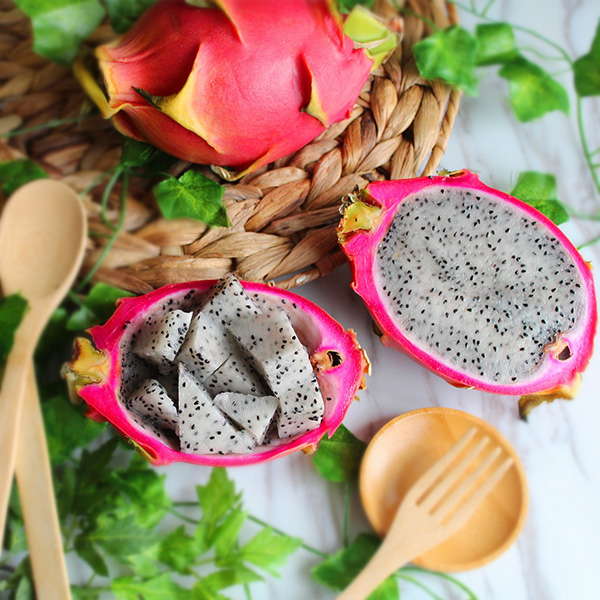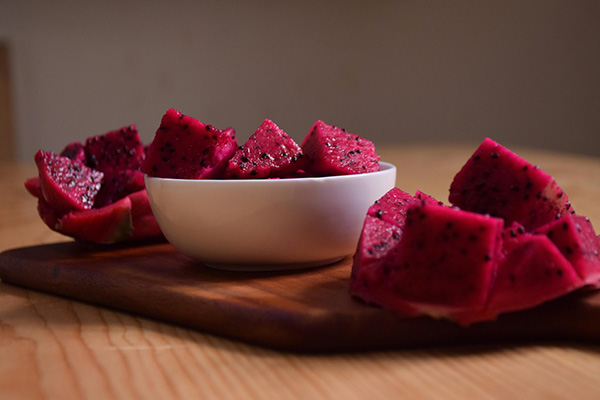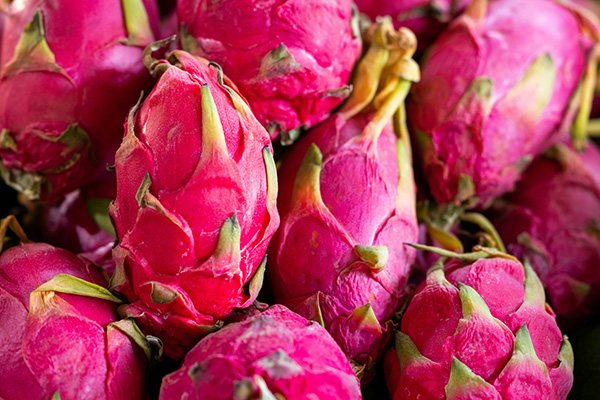Dragon fruit is a vibrant, bizarre-looking, delicious tropical fruit that can add variety to your routine. With its vivid hues and unique shape, this exotic fruit is not just a feast for the eyes but also a treasure trove of nutrition and flavor. Encased in its flamboyant, spiky exterior lies a universe of sweet, subtly earthy flavors offering a unique addition to any healthy diet.
In the post below, we will discuss dragon fruit's origin, the potential health benefits of dragon fruit, and how you can enjoy this delicious tropical fruit.
What Is Dragon Fruit?
Dragon fruit, commonly called "pitaya" or "strawberry pear," is a tropical fruit that traces its origins back to the Americas. It is extensively cultivated in Southeast Asia and various regions with warm climates.
Dragon fruit belongs to the cactus family Hylocereus, a climbing variety indigenous to southern Mexico and northern Central America. The fruit has a bright, leathery skin, typically deep pink or red with green scale-like protrusions, resembling a dragon, hence its name.
The most common variety of dragon fruit is a bright pink oval with green-tipped scales, but the inside of dragon fruit is bright white with hundreds of tiny black seeds. The inside of the fruit features either white or vibrant magenta flesh dotted with small black seeds.
What Does Dragon Fruit Taste Like?
With its striking appearance, dragon fruit offers a taste experience as unique as its look. Upon the first bite, you'll be greeted by a mildly sweet and subtly earthy flavor reminiscent of a blend between a kiwi and a pear.
Dragon fruit's texture is refreshingly light and slightly crunchy, owing to its multitude of tiny, edible seeds, much like a kiwi. Some varieties lean towards a more watermelon-like sweetness, while others offer a faintly tangy twist. Its gentle sweetness and delicate texture make dragon fruit a delightful and exotic treat, perfect for invigorating the palate with a hint of tropical elegance.
Different Types Of Dragon Fruit
Dragon fruit looks a bit outrageous, and there are many varieties on the market.
Pink Skin with White Flesh
Pink dragon fruit is the most well-known variety of dragon fruit, but it's also the least sweet. Alice, Cosmic Charlie, and Guyute are various with this appearance and flavor.
Pink Skin with Red or Pink Flesh (red dragon fruit)
The red dragon fruit variety is larger in size and sweeter and can be found in grocery stores under the names Red Jaina and Bloody Mary.
Pink Skin with Purple Flesh
This dragon fruit tastes similar to the other dark flesh varieties and is called American Beauty.
Yellow Skin with White Flesh
This variety is Often called yellow dragon fruit and is the hardest to source but tastes the sweetest. Yellow dragon fruit often has thorns on the fruit, but the skin of the dragon fruit isn't eaten anyway.

Dragon Fruit Nutrition facts
Based on a serving size of 100 grams (about 3.5 ounces)
- Calories: 50-60
- Protein: 1-2 grams
- Fat: <1 grams
- Carbs: 11-13 grams
- Fiber: 3 grams
- Vitamin C: 5% of the DV
- Iron: 1% of the DV
- Magnesium: 2% of the DV
Health Benefits Of Eating Dragon Fruit
Good For The Gut
Dragon fruit is packed with dietary fiber, which promotes digestive health. The daily dietary fiber recommendation for adults is a minimum of 25 grams, and dragon fruit provides 7 grams in a single 1-cup serving.
Fiber aids in regular bowel movements helps prevent constipation and supports a healthy gut microbiome. Additionally, the fiber in dragon fruit contributes to a feeling of fullness, aiding in weight management and appetite control. Moreover, a diet rich in dietary fiber has been linked to various health benefits, including lower cholesterol levels and reduced risk of heart disease.
Nutrient Dense
This exotic fruit is loaded with essential vitamins and minerals, making it a nutrient-dense choice for any diet. Rich in, dragon fruit boosts the immune system, absorbs iron, and enhances skin health through its antioxidant properties. It also provides B vitamins, which are vital for energy metabolism and maintaining good health.
Dragon fruit is packed with iron. A cup of dragon fruit contains 8% of the daily recommendation of iron. Iron is important for healthy blood and increased energy. Iron, present in dragon fruits, is great for boosting the hemoglobin levels in anemic individuals. It also aids in producing red blood cells (RBCs), which then helps properly oxygenate vital organs.
Additionally, dragon fruit contains significant amounts of iron and magnesium, minerals crucial for overall bodily functions, such as oxygen transport and muscle and nerve function. The presence of antioxidants, including betalains and flavonoids, further elevates its health profile, helping to combat oxidative stress and reduce the risk of chronic diseases.
Loaded in Antioxidants
Dragon fruit is packed with powerful antioxidants like betalains, hydroxycinnamates, lycopene (only in red flesh dragon fruit), and flavonoids. These compounds are essential in neutralizing harmful free radicals in the body, reducing oxidative stress, and preventing cellular damage. The antioxidants in dragon fruit are crucial in combating inflammation, supporting heart health, and potentially reducing the risk of chronic diseases such as cancer and heart disease.
Promote healthy gut
One of the less known dragon fruit benefits is that dragon fruit is a natural source of probiotics. Probiotics are beneficial bacteria that promote a healthy gut microbiome, essential for good digestion, nutrient absorption, and a strong immune system.
Some studies have shown that dragon fruit promotes the growth of healthy bacteria in our guts. All nutrition begins in the gut, and a healthy gut microbiome lets you digest and use as many nutrients as possible from your foods.
Consuming dragon fruit can help maintain the balance of good bacteria in the gut, which is crucial for overall digestive health. Regular intake of dragon fruit can aid in preventing gastrointestinal issues, enhancing gut flora, and potentially boosting immune function.
How Do You Prepare Dragon Fruit?

The outside appearance of dragon fruit may look intimidating, but it's really very easy to cut into it and eat it, and it's rather similar to an avocado. There are many ways to cut a dragon fruit and eat dragon fruit; here are some examples:
- Choose a ripe dragon fruit. It should be slightly soft with evenly colored skin. If it's too firm, leave it on your counter to ripen for a few days. If finding dragon fruit in your grocery store is a struggle, try looking in an Asian market instead.
- Use a sharp knife to slice the fresh dragon fruit in half simply.
- Use a spoon or a melon baller to scoop out the flesh and discard the skin. The seeds are perfectly fine to eat, just like the tiny black seeds in kiwi.
Most people eat dragon fruit like they'd eat any other fresh fruit or incorporate it into various dragon fruit recipes. You can use it to top salads with it or add them to a Greek yogurt parfait. Some even throw it on the grill, similar to pineapple. It pairs particularly well with fish, such as cod, tuna, and mahi mahi. You can add it to smoothies, smoothie bowls, and cocktails or use the juice to make dragon fruit juice.
Picking The Perfect Dragon Fruit
Dragon fruit is only in season from summer to early fall. Although you might find it in stores during other times of the year, it will not be as sweet (or as affordable!) as when it's in season.
Like other tropical fruits, the color of the fruit is a good indicator of its ripeness. The green scales will remain green, but the rest of the fruit will become a deeper pink or yellow as it ripens.
Although the green scales will not change color, they are also a good indicator of ripeness. The fruit is probably ripe once the scales start to droop and wither. Try to buy a dragon fruit with green scales that have begun to brown and dry out.
Perfectly ripe dragon fruit should feel similar in texture to a ripe mango or avocado. It should feel soft and yield to light pressure. If it's too firm, it's not ripe. If it's mushy, it's too far along.
How To Store Dragon Fruit

Avoid cutting your dragon fruit until you're ready to eat it. Once cut, it must be refrigerated in a tightly sealed container. This fruit can pick up the flavors and odors of other food, so protection is necessary. Depending on how ripe it is, it can remain fresh for a day, possibly a little longer. Once the flesh turns brown and gets mushy, it's time to toss it.
If you need to store dragon fruit for an extended period, consider cutting it into chunks and freezing it. Seal the pieces in an airtight container or freezer-safe bag. Frozen dragon fruit is perfect for smoothies or as a cold snack, although its texture may change slightly when thawed.

